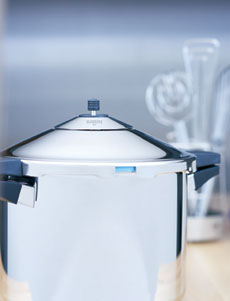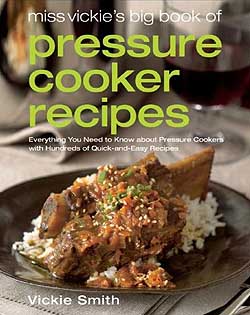
Pressure cooking is the new “fast food”: Your favorite dishes cook in half the time or less.
|
KRISTI EVANS is an intern at THE NIBBLE.
|
|
June 2008
Last Updated July 2010
|
 |
Pressure Cooking
Kuhn Rikon’s Pressure Cooker & Miss Vickie’s Pressure Cooker Recipes Make Delicious Meals A Snap
CAPSULE REPORT: If you prefer a home-cooked meal, but lack the time or stamina to make an entire meal from scratch, you need a pressure cooker. This is not your mother’s pressure cooker: With a stainless steel steaming plate that is dishwasher safe and user-friendly operation (easy, no hissing or rattling), it’s the new must-have appliance for any busy person. Instead of long, slow cooking in a crock pot, pressure cooking is short and fast. You can cook high-fiber, low-fat foods in record time, preserving vitamins and essential nutrients. And pressure cooking creates a greener kitchen, since faster cooking means less fuel burned. This is Page 1 of a four-page article. Click on the black links below to visit other pages.
Overview
Don’t have the time to prepare homemade meals every night? Want a homemade meal anyway? A pressure cooker is your solution. Pressure cooking is a method of preparing food in a sealed, airtight vessel at a pre-set pressure (depending on the food). Because the boiling point of water (or other cooking liquid) increases as the pressure increases, the pressure built up inside the cooker allows the cooking liquid to rise to a higher temperature before boiling. The result: Everything cooks much more quickly.
When you can make an all-inclusive meal in less than 30 minutes, you don’t have to justify the purchase of a new appliance: It pays its way to the dinner table. Kuhn Rikon’s Duromatic line, gleaming stainless steel beauties with modern design, are also kitchen eye candy—handsome pots.
But most important, when we made a Rustic Lamb in Garlic Sauce dinner in 20  minutes, we knew that pressure cooking would bring permanent efficiency, ease and time savings to our life, such that we were hooked. After a bit of soaking and one spin in the dishwasher, we turned out a moist cheesecake in another 20 minutes—yes, a rich, moist New York-style cheesecake that no one would imagine had come from the pressure cooker instead of the oven. minutes, we knew that pressure cooking would bring permanent efficiency, ease and time savings to our life, such that we were hooked. After a bit of soaking and one spin in the dishwasher, we turned out a moist cheesecake in another 20 minutes—yes, a rich, moist New York-style cheesecake that no one would imagine had come from the pressure cooker instead of the oven.
Along with our new cookbook, Miss Vickie’s Big Book of Pressure Cooker Recipes, we no longer think of the fatigue of cooking after a long day at work: We’re energized to cook everything we possibly can in our new pressure cooker. Next up: Mexican Posole, a pork stew with green chile and hominy; Walnut Chicken Braised in Pomegranate Juice; and all six variations of the Sweet Dumpling Flan with Caramel Sauce. (There are eight additional pressure cooker cookbooks listed on Amazon.com.)
The History Of Pressure Cooking
The earliest version of a pressure cooker was created from cast iron in 1679 or 1680 by Denis Papin, a French physicist. It was called Papin’s Digester, a closed vessel with a tightly-fitting lid that confined the steam. (In fact, observing that the steam in the vessel raised the lid, Papin conceived of using steam to power a piston and cylinder—the concept behind the steam engine.) The cover had a safety valve, to guard against explosion due to excessive pressure build-up. However, Papin’s device didn’t make it into the kitchen, as he had hoped, but was used as an industrial sterilizer.
More than 250 years later, in the 20th century, Papin’s idea began to find its way into American kitchens. Its popularity grew during World War II, because pressure cookers are a time-saver—their cooking time is much shorter. However, stories of pressure cookers that rattled and hissed and produce overcooked food scared many would-be users away. Legends of explosions deterred others. (Explosions did occur in the earlier days—the valve could get clogged by food. It was replaced with a fuse. At a very high temperature, the fuse, a metal disc, melts and allows the steam to easily run out of the pressure cooker.)
Today’s pressure cookers are a dream to use, thanks to their advanced design and improved safety systems that put the rattling, hissing, explosive past to rest. A good quality pressure cooker can last a lifetime, so it’s worth the initial investment.
Continue to Page 2: The Benefits Of Pressure Cooking
Return To The Article Index Above
© Copyright 2005-
2026
Lifestyle Direct, Inc. All rights reserved. Images are the copyright of their respective owners.

|



